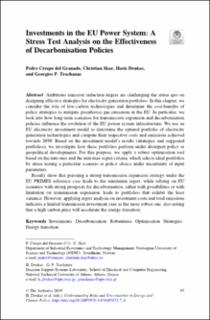| dc.contributor.author | Crespo del Granado, Pedro | |
| dc.contributor.author | Skar, Christian | |
| dc.contributor.author | Doukas, Haris | |
| dc.contributor.author | Trachanas, Georgios P. | |
| dc.date.accessioned | 2020-07-14T09:08:19Z | |
| dc.date.available | 2020-07-14T09:08:19Z | |
| dc.date.created | 2020-06-24T09:00:01Z | |
| dc.date.issued | 2019 | |
| dc.identifier.citation | Understanding Risks and Uncertainties in Energy and Climate Policy. 2019, 97-122, | en_US |
| dc.identifier.isbn | 978-3-030-03151-0 | |
| dc.identifier.uri | https://hdl.handle.net/11250/2663927 | |
| dc.description.abstract | Ambitious emission reduction targets are challenging the status quo on designing effective strategies for electricity generation portfolios. In this chapter, we consider the role of low-carbon technologies and determine the cost-benefits of policy strategies to mitigate greenhouse gas emissions in the EU. In particular, we look into how long-term scenarios for transmission expansion and decarbonisation policies influence the evolution of the EU power system infrastructure. We use an EU electricity investment model to determine the optimal portfolio of electricity generation technologies and compute their respective costs and emissions achieved towards 2050. Based on the investment model’s results (strategies and suggested portfolios), we investigate how these portfolios perform under divergent policy or geopolitical developments. For this purpose, we apply a robust optimisation tool based on the min-max and the min-max regret criteria, which selects ideal portfolios by stress testing a particular scenario or policy choice under uncertainty of input parameters. Results show that pursuing a strong transmission expansion strategy under the EU PRIMES reference case leads to the maximum regret, while relying on EU scenarios with strong prospects for decarbonisation, either with possibilities or with limitation on transmission expansion, leads to portfolios that exhibit the least variance. However, applying regret analysis on investment costs and total emissions indicates a limited transmission investment case as the more robust one, also noting that a high carbon price will accelerate the energy transition. | en_US |
| dc.language.iso | eng | en_US |
| dc.publisher | Springer | en_US |
| dc.relation.ispartof | Understanding Risks and Uncertainties in Energy and Climate Policy : Multidisciplinary Methods and Tools for a Low Carbon Society | |
| dc.rights | Navngivelse 4.0 Internasjonal | * |
| dc.rights.uri | http://creativecommons.org/licenses/by/4.0/deed.no | * |
| dc.title | Investments in the EU Power System: A Stress Test Analysis on the Effectiveness of Decarbonisation Policies | en_US |
| dc.type | Chapter | en_US |
| dc.type | Peer reviewed | en_US |
| dc.description.version | publishedVersion | en_US |
| dc.source.pagenumber | 97-122 | en_US |
| dc.identifier.doi | 10.1007/978-3-030-03152-7_4 | |
| dc.identifier.cristin | 1816876 | |
| dc.relation.project | EC/H2020/642260 | en_US |
| dc.relation.project | EC/H2020/691843 | en_US |
| dc.description.localcode | © The Author(s) 2019 Open Access This chapter is licensed under the terms of the Creative Commons Attribution 4.0 International License (http://creativecommons.org/licenses/by/4.0/), which permits use, sharing, adaptation, distribution and reproduction in any medium or format, as long as you give appropriate credit to the original author(s) and the source, provide a link to the Creative Commons license and indicate if changes were made. The images or other third party material in this chapter are included in the chapter's Creative Commons license, unless indicated otherwise in a credit line to the material. If material is not included in the chapter's Creative Commons license and your intended use is not permitted by statutory regulation or exceeds the permitted use, you will need to obtain permission directly from the copyright holder. | en_US |
| cristin.ispublished | true | |
| cristin.fulltext | original | |
| cristin.qualitycode | 1 | |

